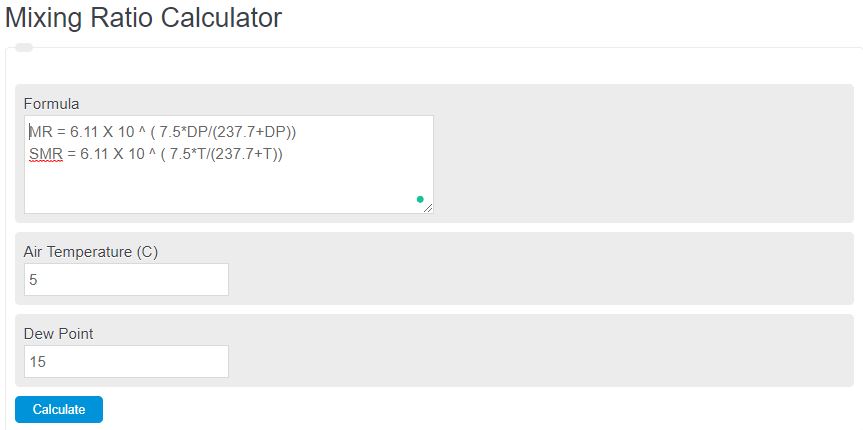Enter the air temperature and dew point into the calculator to determine the 2 mixing ratios.
- Dew Point Calculator
- Wet Bulb Calculator
- Vapor Pressure Calculator (Solvent/Solution)
- Heat Index Calculator
- Relative Humidity Calculator
- Solution Density Calculator
Mixing Ratio Formula
The following 3 formulas are used to calculate the mixing ratio of air.
MR = 6.11 X 10 ^ ( 7.5*DP/(237.7+DP))
SMR = 6.11 X 10 ^ ( 7.5*T/(237.7+T))
- Where DP is the dew point (C)
- T is the temperature
- MR is the mixing ratio
- SMR is the saturated mixing ratio
Mixing Ratio Definition
The mixing ratio is a fundamental concept used to express the ratio of a substance’s mass to the mass of another substance in a mixture. It is a quantitative measure that describes the amount of one component relative to the total components present.
In simpler terms, the mixing ratio represents the proportion of one substance in relation to the total mixture.
Mixing ratio is crucial in numerous fields, particularly in chemistry, physics, meteorology, and engineering. For example, understanding the mixing ratio of reactants in a chemical reaction helps researchers calculate the ideal conditions for maximum yield.
Mixing Ratio Example
How to calculate mixing ratio?
- First, determine the dew point.
Calculate the dew point of the air.
- Next, measure the temperature.
Measure or calculate the temperature of the air.
- Finally, calculate the mixing ratio.
Use the formula above to calculate the mixing ratio.
FAQ
What is the significance of the dew point in calculating the mixing ratio?
The dew point is a critical factor in calculating the mixing ratio as it represents the temperature at which air becomes saturated with moisture. Knowing the dew point allows for the determination of the amount of water vapor in the air relative to its temperature, which is essential for calculating the mixing ratio.
Why is it important to understand the mixing ratio in meteorology and weather forecasting?
In meteorology and weather forecasting, understanding the mixing ratio is crucial because it helps in predicting weather conditions, such as fog, dew, or frost, and in assessing humidity levels in the air. A higher mixing ratio indicates more moisture in the air, which can influence weather patterns and precipitation chances.
Can the mixing ratio affect human comfort and how?
Yes, the mixing ratio can significantly affect human comfort. A high mixing ratio means high humidity levels, which can make the air feel warmer than it actually is because the body’s sweat does not evaporate as efficiently. Conversely, a low mixing ratio indicates dry air, which can lead to skin irritation and respiratory discomfort.
How do changes in the mixing ratio impact the environment?
Changes in the mixing ratio can have various impacts on the environment. For example, a high mixing ratio, indicating high humidity, can lead to increased cloud formation and precipitation, which can affect water cycles and plant growth. On the other hand, low mixing ratios can lead to dryer conditions, potentially increasing the risk of droughts and wildfires.

